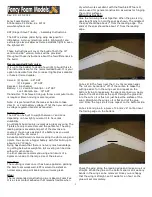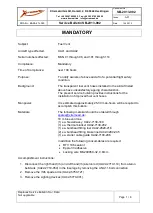
Section 4
Columbia 400 (LC41-550FG)
Normal Procedures
Initial Issue of Manual: November 10, 2004
RC050002
Latest Revision Level/Date: -/11-10-2004
4-25
around the perimeter of the doorframe will remove enough pieces so that the middle portion
of the window can be removed with a few heavy blows. Once the major portion of the
window is removed and if time and circumstances permit, use the ax blade to smooth down
the jagged edges around the doorframe. This will minimize injury when exiting the airplane
through the window.
6.
Oxygen System Operation
– The pilot will notify you when use of oxygen is required. The
pilot will explain use of the equipment and applicable emergency procedures.
7.
No Smoking
– There is no smoking permitted in the airplane, no ashtrays are provided for
smoking, and the airplane is not certified as such. It is a violation of Federal Aviation
Regulations to smoke in this airplane.
CONTROL POSITIONS VERSUS WIND COMPONENT
The airplane is stable on the ground. The low wing design minimizes the tipping tendency from
strong winds while taxiing. Still, the proper positioning of control surfaces during taxiing will
improve ground stability in high wind conditions. The following table, Figure 4 - 4, summarizes
control positions that should be maintained for a given wind component.
Wind Component
Aileron Position
Elevator Position
Left
Quartering Headwind
Left Wing Aileron Up
(Move Aileron Control to the Left)
Neutral
Hold Elevator Control in Neutral Position
Right
Quartering Headwind
Right Wing Aileron Up
(Move Aileron Control to the Right)
Neutral
Hold Elevator Control in Neutral Position
Left
Quartering Tailwind
Left Wing Aileron Down
(Move Aileron Control to the Right)
Down Elevator
(Move Elevator Control Forward)
Right
Quartering Tailwind
Right Wing Aileron Down
(Move Aileron Control to the Left)
Down Elevator
(Move Elevator Control Forward)
Figure 4 - 4
TAXIING
The first thing to check during taxiing is the braking system. This should be done a few moments
after the taxi roll is begun. Apply normal braking to verify that both brakes are operational. The
operation of the turn coordinator and directional gyro can be checked during taxiing provided
enough time has elapsed for the instruments to become stable, normally two to three minutes.
Make a few small left and right S-turns, and check the instruments for proper operation.
When taxiing, minimize the use of the brakes. Since the airplane has a free castoring nose wheel,
steering is accomplished with light braking. Avoid the tendency to ride the brakes by making
light steering corrections as required and then allowing the feet to slide off the brakes and the
heels to touch the floor. Avoid taxiing in areas of loose gravel, small rocks, etc., since it can
cause abrasion and damage to the propeller. If it is necessary to taxi in these areas, maintain low
propeller speeds. If taxiing from a hard surface through a small area of gravel, obtain momentum
before reaching the gravel.
The aircraft should never be taxied while the doors are in the full up position. The doors may be
opened six to eight inches during taxi, which can be controlled by grasping the arm rest or
looping the door strap around the arm.















































